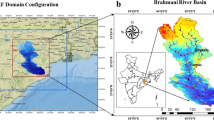Summary
A new typhoon model named as GRAPES_TCM is applied to study the pre-landfall erratic track of Typhoon Haitang (2005), which hit China twice in mid-July by making landfall in Taiwan and Fujian provinces consecutively. The model is based on the Chinese Global/Regional Assimilation and PrEdiction System (GRAPES) and put into real-time operational test since 2004. It predicts almost correctly the pre-landfall loop and sharp turn of Haitang and its asymmetric rainfall distribution.
Haitang’s erratic track is well explained by the potential vorticity (PV) theory on tropical cyclone motion, with the typhoon center moving toward the area of maximum wave-number 1 (WN1) PV tendency most of the time. Among the terms contributing to the WN1 PV tendency, the horizontal advection of PV is dominant with the diabatic heating and residual terms also being not negligible.
A sensitivity experiment is carried out with removal of the Taiwan terrain to determine its importance in the erratic track of Haitang and it is found that the basic erratic feature of Haitang’s track remians unchanged although it tends to have a larger loop and a weaker northward turn, which suggests that Taiwan terrain may not be a key factor here.
The sudden change of Haitang’s moving direction is always accompanied by a newly-generated or re-intensified WN1 PV center in the southern semicircle, which circles around the TC center cyclonically afterwards and weakens in the north or northwestern part. A phase-lock WN1 PV forcing related to diabatic heating is proposed to be the major contributor, the importance of which is magnified as it is in phase with the WN1 horizontal advection of PV. The intrusion of mid-level warm and dry air, as well as the existence of a low-level southwesterly jet, is considered to be the main reasons for such a phase-lock of the diabatic heating forcing on the PV tendency field that finally results in the erratic track of Haitang.
Similar content being viewed by others
References
S Brand JW Blelloch (1974) ArticleTitleChanges in the characteristics of typhoons crossing the island of Taiwan Mon Wea Rev 102 708–713 Occurrence Handle10.1175/1520-0493(1974)102<0708:CITCOT>2.0.CO;2
Bryant AC (2004) Annual tropical cyclone report. Joint Typhoon Warning Center, USA
JCL Chan RT Williams (1987) ArticleTitleAnalytical and numerical studies of the beta-effect in tropical cyclone motion. Part 1: Zero mean flow J Atmos Sci 44 1257–1265 Occurrence Handle10.1175/1520-0469(1987)044<1257:AANSOT>2.0.CO;2
JCL Chan FMF Ko YM Lei (2002) ArticleTitleRelationship between potential vorticity tendency and tropical cyclone motion J Atmos Sci 59 1317–1336 Occurrence Handle10.1175/1520-0469(2002)059<1317:RBPVTA>2.0.CO;2
Dehui C, Xue J (2003) A brief introduction of the CMAs GRAPES project. Proc. Int. Workshop on NWP Models for Heavy Precipitation in Asia and Pacific Areas (4–6 February, 2003, Tokyo, Japan), Japan Meteorological Agency and Ship and Ocean Foundation, 2003, pp 139–141
LS Chen HB Luo YH Duan H Yu (2004) ArticleTitleAn overview of tropical cyclone and tropical meteorology research progress Adv Atmos Sci 21 505–514 Occurrence Handle10.1007/BF02915577
M Fiorino RL Elsberry (1989) ArticleTitleSome aspects of vortex structure related to tropical cyclone motion J Atmos Sci 46 975–990 Occurrence Handle10.1175/1520-0469(1989)046<0975:SAOVSR>2.0.CO;2
Huang W, Duan YH, Xue JS, Chen DH (2006) Tropical cyclone numerical model GRAPES_TCMs operational experiments and its performance analysis. Acta Meteorol Sinica (in Chinese) (accepted)
YL Lin SY Chen CM Hill CY Huang (2005) ArticleTitleControl parameters for the influence of a mesoscale mountain range on cyclone track continuity and deflection J Atmos Sci 62 1849–1866 Occurrence Handle10.1175/JAS3439.1
SJ Lord JL Franklin (1987) ArticleTitleThe environment of hurricane Debby (1982). Part 1: Winds Mon Wea Rev 115 2760–2780 Occurrence Handle10.1175/1520-0493(1987)115<2760:TEOHDP>2.0.CO;2
ZX Luo LS Chen (1995) ArticleTitleEffect of the orography of Taiwan island on typhoon tracks Sci Atmos Sin 19 701–706
Mannoji N (2004) Activities of the RSMC Tokyo Typhoon Center. Int. Conf. on Storms, Brisbane, Australia
YQ Wang GJ Holland (1996) ArticleTitleThe beta drift of baroclinic vortices. Part 2: diabatic vortices J Atmos Sci 53 3737–3756 Occurrence Handle10.1175/1520-0469(1996)053<3737:TBDOBV>2.0.CO;2
C-C Wu KA Emanuel (1993) ArticleTitleInteraction of a baroclinic vortex with background shear: application to hurricane movement J Atmos Sci 50 62–76 Occurrence Handle10.1175/1520-0469(1993)050<0062:IOABVW>2.0.CO;2
C-C Wu Y-H Kuo (1999) ArticleTitleTyphoons affecting Taiwan: current understanding and future challenges Bull Amer Met Soc 80 67–80 Occurrence Handle10.1175/1520-0477(1999)080<0067:TATCUA>2.0.CO;2
LG Wu B Wang (2000) ArticleTitleA potential vorticity tendency diagnostic approach for tropical cyclone motion Mon Wea Rev 128 1899–1911 Occurrence Handle10.1175/1520-0493(2000)128<1899:APVTDA>2.0.CO;2
LG Wu B Wang (2001) ArticleTitleEffects of convective heating on movement and vertical coupling of tropical cyclones: a numerical study J Atmos Sci 58 3639–3649 Occurrence Handle10.1175/1520-0469(2001)058<3639:EOCHOM>2.0.CO;2
T-C Yeh RL Elsberry (1993a) ArticleTitleInteraction of typhoons with the Taiwan orography. Part I: Upstream track deflections Mon Wea Rev 121 3193–3212 Occurrence Handle10.1175/1520-0493(1993)121<3193:IOTWTT>2.0.CO;2
T-C Yeh RL Elsberry (1993b) ArticleTitleInteraction of typhoons with the Taiwan orography. Part II: Continuous and discontinuous tracks across the island Mon Wea Rev 121 3213–3233 Occurrence Handle10.1175/1520-0493(1993)121<3213:IOTWTT>2.0.CO;2
Author information
Authors and Affiliations
Rights and permissions
About this article
Cite this article
Yu, H., Huang, W., Duan, Y. et al. A simulation study on pre-landfall erratic track of typhoon Haitang (2005). Meteorol. Atmos. Phys. 97, 189–206 (2007). https://doi.org/10.1007/s00703-006-0252-1
Received:
Accepted:
Published:
Issue Date:
DOI: https://doi.org/10.1007/s00703-006-0252-1




